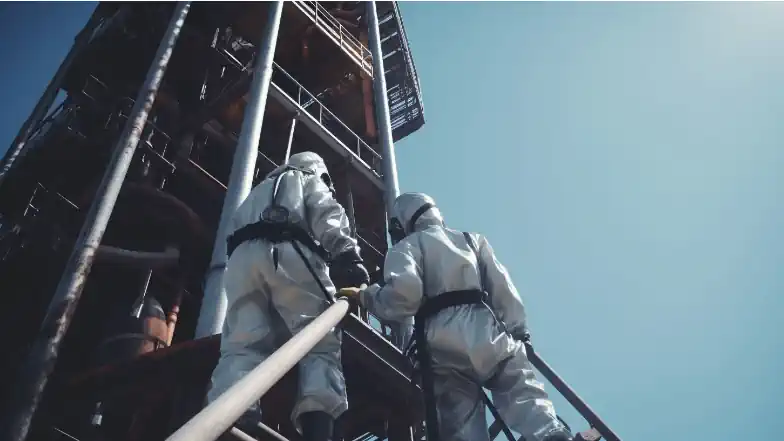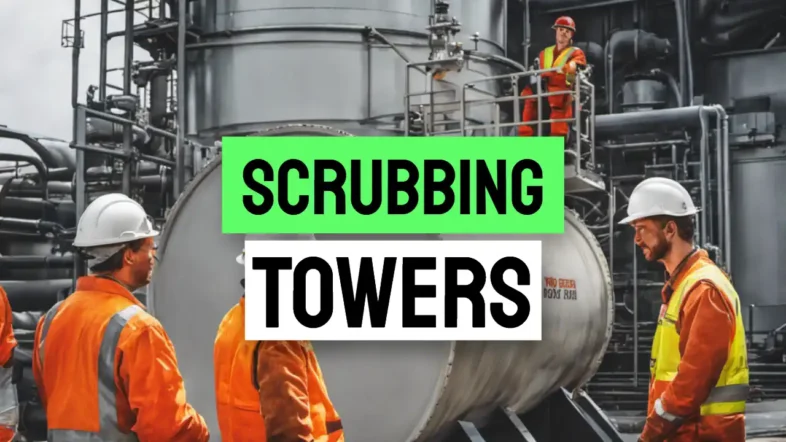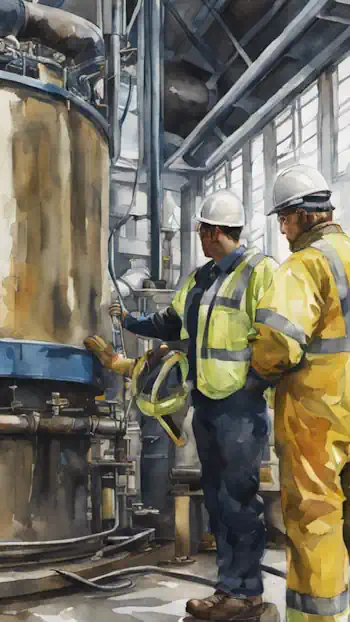In this article, you will find a guide to the benefits of gas scrubbing towers for air pollution control and the useful collection of gases in industrial applications. One example in the waste industry is carbon dioxide capture (CO2) from biogas, and another is the collection of ammonia from the composting process while drying the digestate after anaerobic digestion.

Air pollution is the main driver for most scrubbing tower installations. The quality of the air we breathe has become a major issue globally, raising the need for efficient air pollution control measures. One potent solution is the use of scrubbing towers, which are simple but highly efficient systems designed to remove contaminants from gas streams.
This blog will unravel the efficiency and benefits of these advanced tools, providing you with comprehensive knowledge of their functioning and application.
Why wait? Let’s dive in and explore how scrubbing towers are playing a crucial role in making our world cleaner and healthier. Plus, less smelly as well!
 Key Takeaways
Key Takeaways
- Scrubbing towers are highly efficient systems used to remove contaminants from air and gas streams.
- Wet scrubbing in media-packed towers is a technique used in scrubbing towers that cleans the off-gas from industrial chemical and biological processes to a high degree of purity, while dry scrubbing uses solid material to remove harmful gases.
- Scrubbing towers that are packed with media to provide a large surface area (often plastic-based) provide:
- contra-flow of the gas being treated, which flows upward, while the
- water (or water plus any chemical additive such as alkalinity) trickles downward over a packed filter medium.
- Scrubbing towers often have key features such as:
- high removal efficiency,
- the ability to work with different flow rates, and
- the capability to cool down hot gases.
Packed towers, a type of scrubbing tower, can catch 99.5% of harmful gases and dust from factory processes. They are usually designed based on specific needs and can be adjusted for different types of contaminants.
The Role of Scrubbing Towers
Scrubbing towers (chemical scrubbers), also known as ammonia or CO2 scrubbers (dry or wet scrubbers), are a type of specialized equipment designed to capture and remove chemical gases (such as ammonia) from industrial exhaust streams.
The way these towers work is that they contact the chemically charged air with a liquid, usually water or an alkaline solution, which neutralizes the ammonia (or other gaseous chemical) before it escapes into the air.
Chemical scrubbers are an extremely effective method of removing the unpleasant H2S smell and other odorous, soluble impurities from a smelly airstream.
Given that they can also be used for removing carbon dioxide from a gas flow containing high concentrations of CO2, they are likely to become far more common in the future.
Understanding Scrubbing Towers
Scrubbing towers are used as air pollution control devices or to collect useful gases from a process. As an air pollution control system, a gas scrubber is used to remove contaminants from air and gas streams through various scrubbing techniques, such as wet or dry scrubbing.

Wet scrubbing
Wet scrubbing cleans air and gas. It’s great for taking out things that dissolve in water. This process can cool down hot gases, too. ERG, a UK company, makes wet scrubbing tools using top-class parts to make them work better.
These tools can handle any kind of dirty gas. They also come in many sizes, but they do need to use the right materials for the job at hand. Careful configuration for each project, and off-gas, is essential.
Dry scrubbing
Dry scrubbing works well to control air pollution. It uses solid material instead of liquid in the tower scrubber. In this method, harmful gases like SO2 and HCl are removed from air streams.
The process involves a chemical reaction that changes these bad gases into less harmful ones.
Packed towers are sometimes used in dry scrubbing systems for heat transfer and mass transfer. These towers can operate at high flow rates, which makes them useful for larger applications.
These packed towers need to be designed with care, picking materials based on the contaminants they will face. This makes sure the tower will work well over time without corrosion issues.
Key Features of Scrubbing Towers
Scrubbing towers take care of air pollution in a big way. They have some great features.
- Scrubbing towers can strip away harmful stuff from the air and gas.
- They are the top choice for high-efficiency mass transfer.
- Tower scrubbers can work with different flow rates, up to an amazing 100,000 m³/hr per tower for the really big ones.
- A Packed Tower Scrubber System is super clever at getting rid of almost all contaminants.
- They can also cool down hot gases.
- These towers are tall with vessel diameters commonly going up to 4,000mm and heights up to 10m.
- The best models on sale have everything you need in one place: a scrubber sump tank, chemical dosing systems, and control systems.

The Efficiency of Scrubbing Towers for Air Pollution Control
Scrubbing towers can do an excellent job of controlling air pollution. These devices are good for catching nasty stuff in the air. They trap harmful gases and dust from factories. Packed towers, a type of scrubbing tower, can work really well.
The models commonly on sale can often catch 99.5% of bad gas! These big machines can also cool hot gases that come from factories or power plants. The size and shape of packed towers can change to fit different needs, but they all keep our air clean, no matter what!

Benefits of Scrubbing Towers
Packed Towers provide an efficient solution for air pollution control by removing contaminants from air and gas streams, ensuring high removal efficiency, and minimizing system pressure drop.
Read on to discover the numerous benefits of scrubbing towers in combating air pollution.
Packed Towers
Packed towers serve an important role in air pollution control. They take out harmful parts from air and gas streams. These harmful parts are things that can be dissolved in water.
Packed towers work very well when it comes to mass transfer and heat transfer. This makes them good at cleaning and cooling down hot gas streams.
The leading manufacturer will always help users design their packed towers for each special need or job, making sure they run as best they can while keeping the size of the equipment small. With these designs, packed towers can clear away any soluble gaseous part that is not needed, with a usual success rate of 99.5%.
The flow rate of liquor—the liquid used during the scrubbing process—in packed towers is chosen to make sure there’s great scrubbing action without using too much pump flow or energy.
Packed towers follow standard rules and can be changed based on:
- the kind of bad stuff that needs to be taken out
- how these react chemically, etc.
For instance, if the job calls for dealing with acid gases like HCl, SO2, NH3, or VOCs, then certain changes would be made to the way those types of packed tower scrubbers are designed.

Odorgard™ catalytic, wet chemical scrubbing system
Odorgard™ is a useful tool in fighting air pollution. It uses wet chemical scrubbing to control bad smells and VOCs. This system outdoes old caustic hypochlorite systems. Odorgard™ was made for getting rid of smells from large amounts of air.
It also takes away smelly compounds in places that need good odor control, like big industries. With this system, people live and work in cleaner environments that smell better too.
The Final Word!
Scrubbing Towers are key in fighting air pollution. They work hard to clean the air. Packed towers take out harmful stuff from both air and gas flows. This makes our world a healthier place to live in.

FAQs
1. What are scrubbing towers for air pollution control?
Scrubbing towers for air pollution control are used to make the air clean. They use gas absorption and water-soluble chemicals to catch bad stuff in the air like dust, mercury, and carbon dioxide.
2. How do scrubbing towers work?
Scrubbing towers use a counterflow column. The dirty gas goes up through random or structured media where it meets with cleaning liquid coming down from a spray distributor or distributor tray causing turbulence and mixing action.
3. What parts make up a scrubbing tower system?
A scrubbing tower system has many parts, such as:
- vessels,
- pipework,
- fans,
- a recirculation pump,
- material of construction,
- a control panel,
- an access platform, and
- an instrumentation and control system.
4. Can heat be removed by using inline heat exchangers in Scrubbers?
Yes! Inline heat exchangers can cool saturated gas streams which helps with cooling gases like ammonia from water and flue-gas condensation while also removing acid gases like HCl, SO2 , NH3 , VOCs.
5. Are there standards for making these scrubbers?
Yes! Vessels should be made according to PD5500 (metal) and BS EN 13121 (GRP). All parts should have UKCA or CE marking along with the rules set out by PE(S)R or PED.
At the time of writing, there are secondhand scrubbing towers available here.



 Key Takeaways
Key Takeaways


Not sure how I ended up here. I was looking for a link to my website, so how about this:
“Why did the scrubbing tower break up with its media packing? Because it couldn’t handle the toxic relationship anymore!”